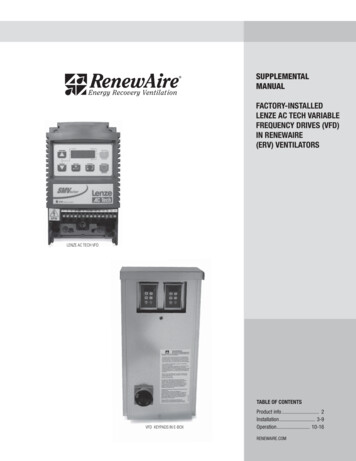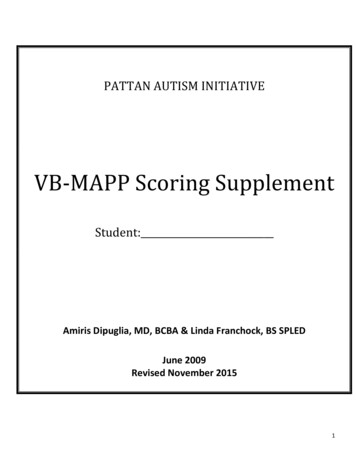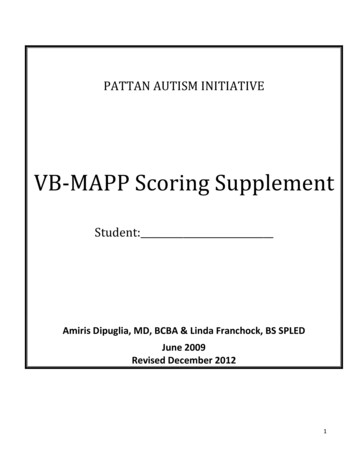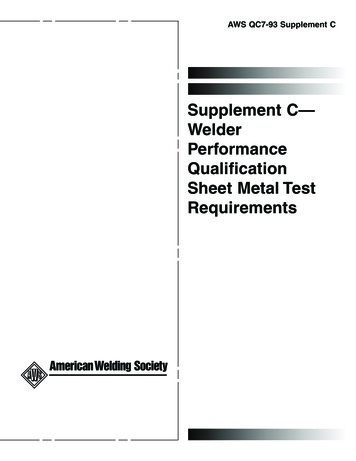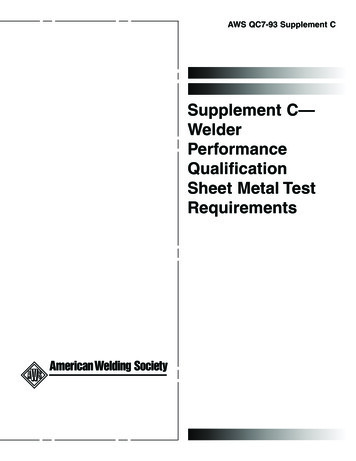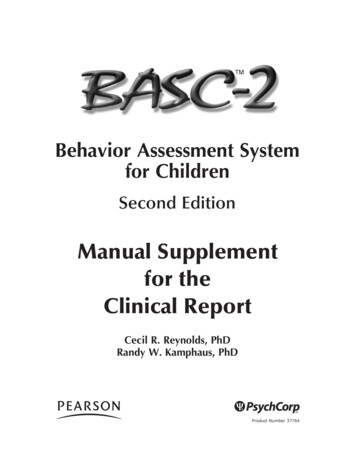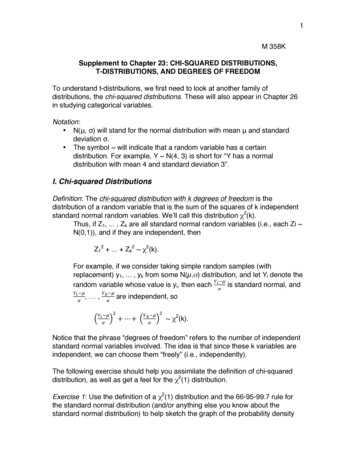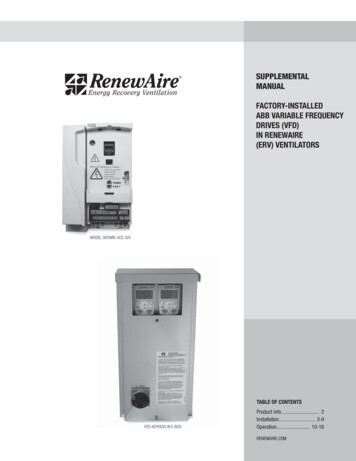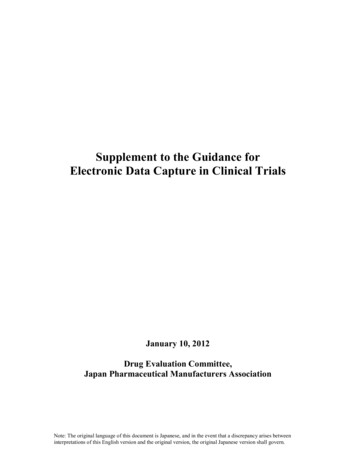
Transcription
Supplement to the Guidance forElectronic Data Capture in Clinical TrialsJanuary 10, 2012Drug Evaluation Committee,Japan Pharmaceutical Manufacturers AssociationNote: The original language of this document is Japanese, and in the event that a discrepancy arises betweeninterpretations of this English version and the original version, the original Japanese version shall govern.
Table of ContentsIntroduction .21Requirements for Using Electronically Collected PRO for Drug Applications .31.1 ePRO and ePRO systems .31.2 Typical business model for ePRO systems .31.3 Regulatory requirements .51.4 Requirements of the GCP.51.5 Requirements of the ER/ES Guidelines .71.5.1 Requirements and operational procedures for authenticity .71.5.2 Requirements and operational procedures for readability.91.5.3 Requirements and operational procedures for retainability .91.5.4 Requirements and operational procedures when an open system is used .102. Important Points concerning the Electronic Data directly obtained from CentralLaboratories .112.1 Qualification of central laboratories .112.2 Verification of transfer and conversion processes of electronic data .112.3 Verification of data by direct access .112.4 Confirmation of received data .123. Requirements for Electronic Signatures Used in eCRFs .133.1 Regulatory requirements .133.2 Operational procedures .13Terms and Definitions .161
IntroductionIn November 2007, the Drug Evaluation Committee of the Japan PharmaceuticalManufacturers Association issued the “Guidance for Electronic Data Capture in ClinicalTrials,” as a voluntary guidance on requirements to be met in the electronic capture of clinicaltrial data1 (“Guidance 2007”).The scope of Guidance 2007 was limited to the data entered at the sites by EDC systems (eCRF),related audit trails, and electronic data obtained from central laboratories etc. Recently, theimplementation of the Electronic Patient Reported Outcomes (ePRO) systems, which were notincluded in the scope of Guidance 2007, has gradually started. Since ePRO systems areeffective for identifying subjects’ compliance status with the protocol and obtaininghigh-quality subject-reported data, the use of this system is expected to expand further.With ePRO systems, data may be managed by the Contract Research Organization, or may bestored in devices and subsequently sent to vendor servers. Therefore, Guidance 2007, providedmainly for eCRF, cannot be applied to ePRO systems as is. It is needless to say that recordsmust be formulated and appropriately abided by laws and regulations, in order to fulfillrequirements for a new drug application dossier.This document has been prepared as a supplement to Guidance 2007 to have important pointsbe common view when using ePRO systems.At the same time, some of the contents of Guidance 2007 have been revised, with the focus onthe issue that had already been recognized by the authors and the regulatory authority at thetime of the issuance of Guidance 2007 - concepts concerning the accountability of the sponsorregarding the identicalness between electronic data directly obtained from central laboratoriesand source documents at the sites.Requirements for electronic signatures used in eCRFs have also been reconsidered from theviewpoint of regulatory requirements and operational conditions.This document includes the following supplements to Guidance 2007; Chapter 1“Requirements for Using Electronically Collected PRO for Drug Applications” for regulatoryrequirements and related operation for using ePRO systems, Chapter 2 “Important Pointsconcerning the Electronic Data Directly obtained from Central Laboratories” for revised partsof Guidance 2007 concerning electronic data directly obtained from central laboratories, andChapter 3 “Requirements for Electronic Signatures Used in the df/20071101guidance.pdf2
1Requirements for Using Electronically Collected PRO forDrug Applications1.1 ePRO and ePRO systemsAssessment data directly provided by subjects, pertaining to all aspects of their healthconditions, to which no interpretation is added by physicians or other persons, are called“Patient-Reported Outcomes (PRO)” (reference: FDA’s Guidance for Industry Patient-Reported Outcome Measures: Use in Medical Product Development to SupportLabeling Claims; translated into Japanese by ISPOR Japan Charter’s Working Group). Inrecent years, PRO has increasingly been collected electronically in clinical trials. In thisguidance, electronically collected PRO are hereinafter referred to as “ePRO,” and systems toobtain PRO as source documents and upload PRO to the trial database are referred to as “ePROsystems”.Please note that this guidance provides requirements for the electronic collection of PRO, anddoes not refer to the methods of collection, use etc. of the PRO itself.1.2 Typical business model for ePRO systemsBefore switching from receiving a paper PRO to collecting electronic PRO (ePRO), it isrequired to prepare necessary equipment (e.g. devices) and environment (e.g. internet line,telephone line) for data entry by subjects, make operational procedures for transmitting subjectdata to the operational database, operational procedures for providing the collected subject datato investigators. and sponsors, and also procedures for data retention after completion of theclinical trial and location of storage. As is defined in “PRO,” a system must be established toavoid any interruption or change of data reported by subjects.Figure 1 shows a typical business model of ePRO systems. A subject enters PRO using a device,IVRS (Interactive Voice Response System), or IWRS (Interactive Web Response System). Theentered data are stored in the vendor’s server as source documents. During this process, thevendor ensures reliability of the source documents as a “trusted third party.”During the trial, both the site and sponsor representatives can view the ePRO data in thevendor’s server via web as necessary. The sponsor incorporates the ePRO data in its own trialdatabase. After the completion of the trial, the source documents on the vendor’s server aretransferred to a CD-R or other general media, such as a PDF file or other format that can addressthe requirements of readability and retainability, through a process required for ensuringauthenticity2, and are stored at the site.Definition of the respective data shown in Figure 1 is explained below.First, in case of an ePRO system using an IVRS or IWRS, data in the server is regarded assource data, as it is directly recorded PRO (original). Therefore, the data must include an inputtrail and, in case of correction, an edit trail.2As describing in section 1.5.1, "authenticity" in this document includes the meaning of "integrity".3
In case of an ePRO system using an entry device, data saved in the device is the original recordcreated by the subject, and is thus regarded as the source data. Therefore, the “Usage ofElectromagnetic Records and Electronic Signatures in the Application for Drug Approval orLicensing” must be complied for the device itself. In other words, requirements for authenticity,readability and retainability must be fulfilled under precondition that the device has beenvalidated. These requirements include recording of an audit trail in case the data saved in thedevice are changeable. Encryption or other security methods must be implemented in datatransmission to the server via an open system. Since the data stored in the device lacksdurability, it is necessary to transfer the data to a durable ePRO server at an early stage, by averified procedure.Next, data that has been transferred from the server to a CD-R or other recording media withintention of source data transfer after the completion of the trial, are regarded as a new sourcedocument as long as a copy of the data including the audit trail has been certified afterverifications as being certified copies (note: The GCP definition of “source documents”includes copies and transcriptions certified after verification as being certified copies). Sincethe data is copied with the intention to transfer source documents, the relevant CD-R or otherrecording media is considered as the source documents, and the data in the server is no longerconsidered as the source documents, once transfer is completed.On the other hand, data that the sponsor obtains from the vendor and stores into its database ismerely considered as a dataset. This dataset is being used for analysis activities, but does notusually contain input and edit trails, etc. In other words, the vendor provides the relevant data,but the source documents of ePRO have not been transferred to the sponsor.SiteSponsorSite/sponsor viewsthe data via webElectronic data (CD-R/DVD) areprovided after the completion ofthe trial, as source documents to beretained at the siteSubjectDevice etc. for dataentry by patientTransmit dataperiodically/as necessarySourcedocumentsIncorporate electronicdata periodicallyVendorePRO serverFigure 1. Typical business model of ePRO systems4Sponsor’sdatabase
1.3 Regulatory requirementsBased on the following regulations, the application and retention by electromagnetic recordsare admitted for a new drug application dossier. Important points are also specified in theregulations. Laws on the Usage of Information Technology for Saving Documentations by PrivateBusinesses (Law No. 149 of 2004, hereinafter referred to as “e-Document Law”) Ministerial Ordinance on the Usage of Information Technology for SavingDocumentation by Private Businesses, pursuant to the Provisions of Laws andRegulations under the Jurisdiction of the Ministry of Health, Labor and Welfare(MHLW Ordinance No. 44 of 2005, hereinafter referred to as “Ordinance of theGoverning Ministry”) “Usage of Electromagnetic Records and Electronic Signatures in the Application forDrug Approval or Licensing” (PFSB Notification, dated April 1, 2005, hereinafterreferred to as “ER/ES Guidelines”)When considering specifications and operation of ePRO systems that handle electronic PRO,the regulatory requirements listed above must be complied. In addition to the above, thefollowing regulatory requirements must also be complied. Ministerial Ordinance on Good Clinical Practice for Drugs (MHW Ordinance No. 28 of1997, hereinafter referred to as “GCP Ordinance”) “Enforcement of Standards on the Conduct of Clinical Trials for Drugs” (PFSB/ELDNotification No. 1001001, dated October 1, 2008; superseded by the PFSB/ELDNotification No.1024-1, dated October 24, 2011 from April 1, 2012 onward; hereinafterreferred to as “GCP Enforcement Notification”).Sections 1.4 and 1.5 focus on provisions of the GCP and requirements of the ER/ES Guidelinesthat must particularly be complied when using ePRO systems.1.4 Requirements of the GCPGCP stipulates retention of trial records, including both paper documents and electronic data.The sponsor must fulfill the requirements provided in Article 26 (Record Keeping), and the sitemust meet the requirements provided in Article 41 (Record Keeping).Article 26, Paragraph 1-3 of the GCP Enforcement Notification specifies requirements for datahandling using an electronic data processing systems (including remote electronic datasystems), as follows.When an electronic data processing system (including remote electronic data systems) is usedto handle clinical trial data, the sponsor shall conduct the following:5
1) Ensure and document that the electronic data processing systems fulfill the sponsor’sestablished requirements for completeness, accuracy, reliability and consistent intendedperformance (i.e. validation);2) Maintain the operating procedures for using these system;3) Ensure that the systems are so designed as to permit data correction in such a way that thedata correction are documented and that all records of correction of entered data remainundeleted as logs distinguishable to the inputter as well as to the corrector (i.e. to maintainaudit trail, input trail, and edit trail);4) Maintain a security system for the data;5) Maintain the adequate backup of the data;6) Prepare and maintain a list of the individuals who are authorized to make data correction;and7) Keep the blinding in case of a blinded clinical trial.Since ePRO systems are included in “electronic data processing systems,” the sponsor mustnote the above requirements when selecting an ePRO system to be used.When conducting data-converting operations on data in an ePRO system, the followingrequirements, provided in Article 26, Paragraph 1-4 of the GCP Enforcement Notification,must be fulfilled.If data are converted during the processing, the sponsor should ensure that it is always possibleto compare the original data with the processed data.Article 41 of the GCP lays down the requirements for record keeping at the site, including thesource documents.As for ePRO system, which records assessment by subjects directly in electronic data, the datastored in the system server is expected to be used as source documents. Unlike data collected inthe CRF, such ePRO source documents are not managed by the site. Therefore, the sponsormust always document which data must be used as the source documents.For example, an ePRO system using a data entry device saves data within the devicetemporarily, and transfers the data to the ePRO server by a pre-defined timing and procedure.During this process, the data saved in the device are temporarily regarded as source documents.After the data is transferred to the ePRO server, the data in the ePRO server are considered assource documents. It is necessary to identify the “source documents” in the protocol etc., anddocument the timing and locations of source document storage.It must also be noted that, the ePRO must be durable enough to be kept for their retention periodspecified in Article 26 of the GCP, “The sponsor shall appropriately retain the records,” sinceePRO refers to “data generated in conducting the clinical trial”.6
1.5 Requirements of the ER/ES GuidelinesAn ePRO system that handles PRO electronically, must comply “3. Requirements for the Usageof Electromagnetic Records” of the ER/ES Guidelines. In other words, 1) authenticity, 2)readability and 3) retainability of electromagnetic records must be ensured. As a preconditionfor this process, the reliability of an ePRO system must be ensured through ComputerizedSystem Validation (CSV).4) When Open Systems such as internet are used, additional measures must also be taken toensure the authenticity and confidentiality of the electromagnetic records from their creation toreceipt.The requirements and operational procedures of the four points indicated above are described inthe subsequent sub-paragraphs.1.5.1Requirements and operational procedures for authenticityThe ePRO system must be complete, accurate and reliable, and the responsibilities for thecreation, change and deletion of data are clarified. To ensure authenticity, the followingrequirements must be fulfilled. “Entry” refers to the creation of new data, and “correction”refers to change or deletion of the existing data.1) The ePRO system is designed to enable assignment of authorities in accordance with theresponsibility of the users, as well as correct entry of the intended data under the assignedauthorities. User management and authority setting must be appropriately undertaken, as per thepre-set rules. Authentication of users who access the system must be established.A combination of at least two elements must be used for user authentication beforeaccess. For example, in case of an ePRO system using a mobile information terminal orsimilar device, a user must be authenticated using his/her subject ID (case number),which is pre-registered by the site’s administrator, and the access code (PIN number orpassword) entered by the subject. In case of an ePRO system using an IWRS, an ID andpassword entered by the subject must be used for his/her authentication. Appropriate training must be provided to ensure appropriate usage and compliance.Since the users of an ePRO system are subjects, it is essential to provide them withunderstandable manuals and pre-trial trainings using equipment related to the ePROsystem in order to collect intended data and improve quality of the trial data. It must benoted that, basic handling procedures of equipment and management of passwords andIDs must be included in the training program. It is also desirable to establish a help deskin advance to minimize loss of data reliability due to missing data that may be caused bydevice failure, forgotten access codes etc., and subsequent transcription from papermedia. The following points must be confirmed in advance, through User Acceptance Test ofthe ePRO system;7
The entered data are accurately recorded as intended, can be confirmed on the displayscreen etc., and are accurately transferred to the server. The system is also designed toensure that the intended data are entered accurately under the assigned authorities. An audit trail can be retained automatically.Together with the entered data, the date and time of entry and the person who enters thedata can be recorded. If the system is also designed to permit data correction, then thedata corrections are documented and that all records of correction of entered data remainundeleted as unchangeable logs distinguishable to the inputter as well as to the corrector,automatically. Accurate time stamps of data entry can be recorded.One of the significant advantages of using an ePRO system is the recording of timestamps of data entry. The date and time should be set accurately.2) Security is maintained in the ePRO system and its operational procedures. An audit trail shall enable identification of the persons who entered the data, the entereddata and the time of entry. In case of correction, the persons who corrected, thecorrection details and the time of correction must be identifiable. The system must be designed to prevent and/or detect unauthorized access.For examples, the system has a function that demands an access code in case of loss ofa device, or a specific equipment or program to download data from the device, etc.3) The operation and management of the process should ensure the same data quality as that ofthe clinical data collected in a paper PRO (e.g. subject diary). The time and location of storage of data collected by an ePRO system must be identifiedand documented in advance. After the completion of the trial, the electronic data including the audit trail managed inthe vendor’s ePRO server must be transferred to a CD-R or other alteration-proofrecording media, through a pre-verified pro
clinical trial and location of storage. As is defined in “PRO,” a system must be established to avoid any interruption or change of data reported by subjects. Figure 1 shows a typical business model of ePRO systems. A subject enters PRO using a device, IVRS (Interactive Voice Response System



